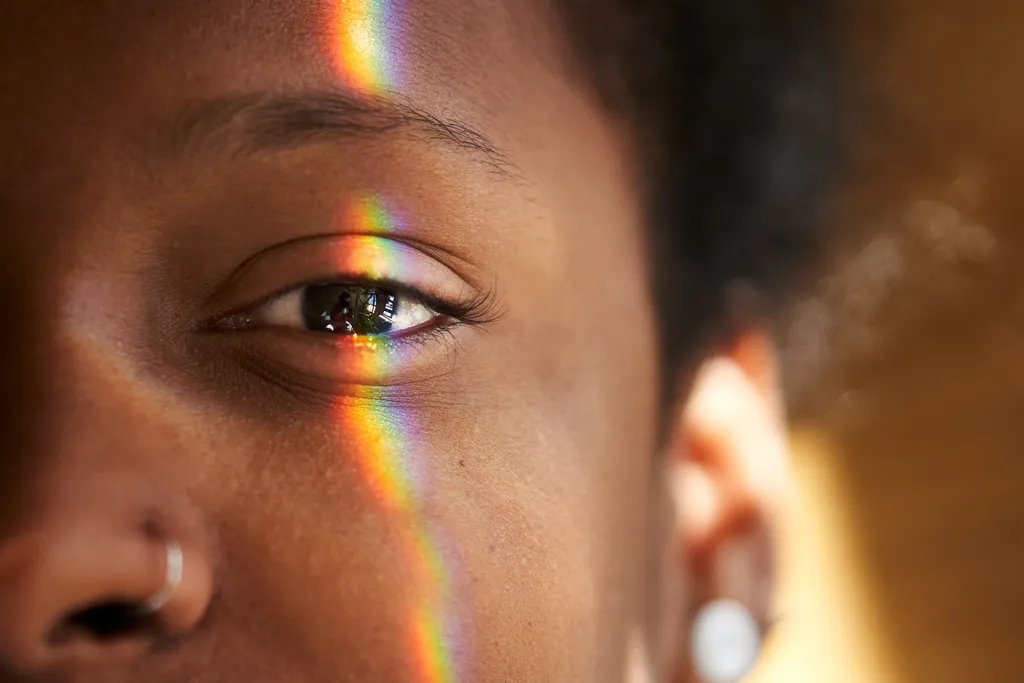Scientists Say They've Discovered a New Color—an 'Unprecedented' Hue Only Ever Seen by Five People
Scientists Say They’ve Discovered a New Color—an ‘Unprecedented’ Hue Only Ever Seen by Five People
The color, dubbed olo, is described as an intensely saturated teal. Researchers say it might have applications in understanding color blindness
Human perception of color is regulated by three types of cone cells in the eye. By artificially stimulating just one type with a laser, researchers and study participants experienced a new color they call "olo."
Carlos Barquero via Getty Images
Five people have experienced what scientists say is a brand-new color dubbed “olo,” thanks to an experiment that involved firing laser pulses into their eyes.
The method allowed them to see a vibrant hue they described as a “blue-green of unprecedented saturation,” according to a new paper published in the journal Science Advances
“It was jaw-dropping. It’s incredibly saturated,” says study co-author Ren Ng, an electrical engineer at the University of California, Berkeley, and one of the participants who saw olo, to Ian Sample at the Guardian. “We predicted from the beginning that it would look like an unprecedented color signal, but we didn’t know what the brain would do with it.”
Human retinas typically have three types of cone cells, which are what allow our eyes to detect various wavelengths of light. L cones detect long wavelengths, which we see as red. M cones detect medium wavelengths, which we see as green. And S cones pick up on short wavelengths, which we see as blue.
If the middle-wavelength M cones are activated under natural conditions, either S or L cones will also be activated, since the cones overlap a little in the wavelengths they detect. So, the researchers wondered what would happen if only the M cone was stimulated. To do that, they used a device called Oz, which is equipped with a laser that can stimulate single cone cells.
Five people—four male and one female—participated in the study, and three of them were on the research team. The other two participants were scientists at the University of Washington who didn’t know anything about the purpose of the experiment.
First, the researchers mapped part of each participant’s retina to determine the position of each type of cone cell. Then, they stimulated just the M cones with the laser and asked them to describe what they saw. Ng tells BBC Radio 4 that olo is “more saturated than any color that you can see in the real world.”
This teal represents the closest color to the newly described "olo," but scientists say the true hue can't be seen without their experimental laser setup.
Screenshot, hexadecimal color #00ffcc
“Let’s say you go around your whole life and you see only pink, baby pink, a pastel pink,” he adds. “And then one day you go to the office and someone’s wearing a shirt, and it’s the most intense baby pink you’ve ever seen, and they say it’s a new color and we call it red.”
To make sure the participants were really seeing a new color, they also took a color-matching test. In one of the experiments, participants viewed olo beside an adjustable hue and were asked to match its shade to olo as closely as possible. The participants selected a teal color. Then, the research team asked them to turn a dial to adjust olo by adding or removing white light, until it matched the saturation of a teal. All participants desaturated olo by adding white light to bring it closer to the teal.
“It’s a fascinating study, a truly groundbreaking advance in the ability to understand the photoreceptor mechanisms underlying color vision. The technical demands necessary to achieve this are enormous,” says Manuel Spitschan, a light researcher at the Max Planck Institute for Biological Cybernetics who was not involved in the study, toScientific American. “An open question is how this advance can be used.”
Some researchers say the work could have medical applications. Andrew Stockman, a vision researcher at University College London, tells Carissa Wong at New Scientist
Not everyone is convinced that olo is truly a new color, however. John Burbur, a vision researcher at the University of London, tells the Guardian that the work has “limited value.”
“It is not a new color,” he says. “It’s a more saturated green that can only be produced in a subject with normal red-green chromatic mechanism when the only input comes from M cones.”
Unfortunately, most people aren’t likely to experience olo for now. It can only be seen using the Oz laser technology in a scientific lab. “This is basic science,” Ng tells the Guardian. “We’re not going to see olo on any smartphone displays or any TVs any time soon. And this is very, very far beyond VR headset technology.”
Get the latest stories in your inbox every weekday.


